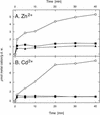Interplay of the Czc system and two P-type ATPases in conferring metal resistance to Ralstonia metallidurans
- PMID: 12867443
- PMCID: PMC165768
- DOI: 10.1128/JB.185.15.4354-4361.2003
Interplay of the Czc system and two P-type ATPases in conferring metal resistance to Ralstonia metallidurans
Abstract
Cadmium and zinc are removed from cells of Ralstonia metallidurans by the CzcCBA efflux pump and by two soft-metal-transporting P-type ATPases, CadA and ZntA. The czcCBA genes are located on plasmid pMOL30, and the cadA and zntA genes are on the bacterial chromosome. Expression of zntA from R. metallidurans in Escherichia coli predominantly mediated resistance to zinc, and expression of cadA predominantly mediated resistance to cadmium. Both transporters decreased the cellular content of zinc or cadmium in this host. In the plasmid-free R. metallidurans strain AE104, single gene deletions of cadA or zntA had only a moderate effect on cadmium and zinc resistance, but zinc resistance decreased 6-fold and cadmium resistance decreased 350-fold in double deletion strains. Neither single nor double gene deletions affected zinc resistance in the presence of czcCBA. In contrast, cadmium resistance of the cadA zntA double mutant could be elevated only partially by the presence of CzcCBA. lacZ reporter gene fusions indicated that expression of cadA was induced by cadmium but not by zinc in R. metallidurans strain AE104. In the absence of the zntA gene, expression of cadA occurred at lower cadmium concentrations and zinc now served as an inducer. In contrast, expression of zntA was induced by both zinc and cadmium, and the induction pattern did not change in the presence or absence of CadA. However, expression of both genes, zntA and cadA, was diminished in the presence of CzcCBA. This indicated that CzcCBA efficiently decreased cytoplasmic cadmium and zinc concentrations. It is discussed whether these data favor a model in which the cations are removed either from the cytoplasm or the periplasm by CzcCBA.
Figures






Similar articles
-
The efflux system CdfX exports zinc that cannot be transported by ZntA in Cupriavidus metallidurans.J Bacteriol. 2024 Nov 21;206(11):e0029924. doi: 10.1128/jb.00299-24. Epub 2024 Oct 30. J Bacteriol. 2024. PMID: 39475293 Free PMC article.
-
First step towards a quantitative model describing Czc-mediated heavy metal resistance in Ralstonia metallidurans.Biodegradation. 2003 Apr;14(2):153-68. doi: 10.1023/a:1024043306888. Biodegradation. 2003. PMID: 12877469
-
CzcP is a novel efflux system contributing to transition metal resistance in Cupriavidus metallidurans CH34.Mol Microbiol. 2009 Aug;73(4):601-21. doi: 10.1111/j.1365-2958.2009.06792.x. Epub 2009 Jul 7. Mol Microbiol. 2009. PMID: 19602147
-
Cupriavidus metallidurans: evolution of a metal-resistant bacterium.Antonie Van Leeuwenhoek. 2009 Aug;96(2):115-39. doi: 10.1007/s10482-008-9284-5. Epub 2008 Oct 1. Antonie Van Leeuwenhoek. 2009. PMID: 18830684 Review.
-
Bacterial heavy metal resistance: new surprises.Annu Rev Microbiol. 1996;50:753-89. doi: 10.1146/annurev.micro.50.1.753. Annu Rev Microbiol. 1996. PMID: 8905098 Review.
Cited by
-
Permanent draft genome sequences of cadmium-resistant isolates of Cupriavidus from soils within the Tar Creek Superfund site.Microbiol Resour Announc. 2025 Jan 16;14(1):e0081824. doi: 10.1128/mra.00818-24. Epub 2024 Nov 26. Microbiol Resour Announc. 2025. PMID: 39589146 Free PMC article.
-
Cadmium and Copper Cross-Tolerance. Cu+ Alleviates Cd2 + Toxicity, and Both Cations Target Heme and Chlorophyll Biosynthesis Pathway in Rubrivivax gelatinosus.Front Microbiol. 2020 Jun 3;11:893. doi: 10.3389/fmicb.2020.00893. eCollection 2020. Front Microbiol. 2020. PMID: 32582041 Free PMC article.
-
Survival and growth in the presence of elevated copper: transcriptional profiling of copper-stressed Pseudomonas aeruginosa.J Bacteriol. 2006 Oct;188(20):7242-56. doi: 10.1128/JB.00837-06. J Bacteriol. 2006. PMID: 17015663 Free PMC article.
-
New developments in the understanding of the cation diffusion facilitator family.J Ind Microbiol Biotechnol. 2005 Jun;32(6):215-26. doi: 10.1007/s10295-005-0224-3. Epub 2005 May 12. J Ind Microbiol Biotechnol. 2005. PMID: 15889311 Review.
-
Interplay of different transporters in the mediation of divalent heavy metal resistance in Pseudomonas putida KT2440.J Bacteriol. 2008 Apr;190(8):2680-9. doi: 10.1128/JB.01494-07. Epub 2007 Dec 7. J Bacteriol. 2008. PMID: 18065533 Free PMC article.
References
-
- Bal, N., E. Mintz, F. Guillain, and P. Catty. 2001. A possible regulatory role for the metal-binding domain of CadA, the Listeria monocytogenes Cd2+-ATPase. FEBS Lett. 506:249-252. - PubMed
-
- Deretic, V., S. Chandrasekharappa, J. F. Gill, D. K. Chatterjee, and A. Chakrabarty. 1987. A set of cassettes and improved vectors for genetic and biochemical characterization of Pseudomonas genes. Gene 57:61-72. - PubMed
-
- Fagan, M. J., and M. H. Saier, Jr. 1994. P-type ATPases of eukaryotes and bacteria: sequence comparisons and construction of phylogenetic trees. J. Mol. Evol. 38:57-99. - PubMed
Publication types
MeSH terms
Substances
Grants and funding
LinkOut - more resources
Full Text Sources
Medical

